Presonus Eris E3.5 Review
Incredible value for these full-featured small studio monitors

Reviewed by: Paul Narang
Review date: June 2022
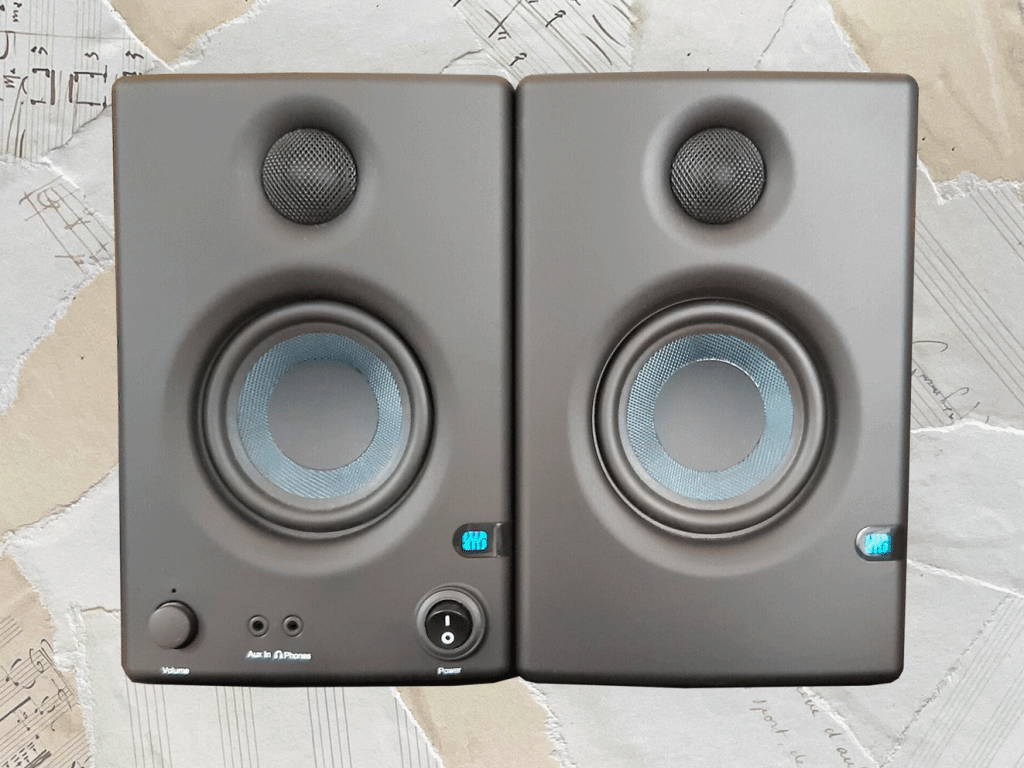

PreSonus Eris E3.5 review
| Pros: | Cons: |
| Incredible value Bass and treble controls Multiple connection options | Limited bass response |
Presonus Eris E3.5 Review
The Eris E3.5 is the smallest in a series of multimedia studio monitors made by PreSonus, which include the E4.5, and E5 BT models. The PreSonus Eris E3.5 monitors are the same size as computer speakers, and fit neatly on the desk either side of the screen.
They’re perfect for small rooms or desktop use, with a clean and balanced sound. You can use the E3.5 monitors as high quality computer speakers, or small scale studio monitors for music production.
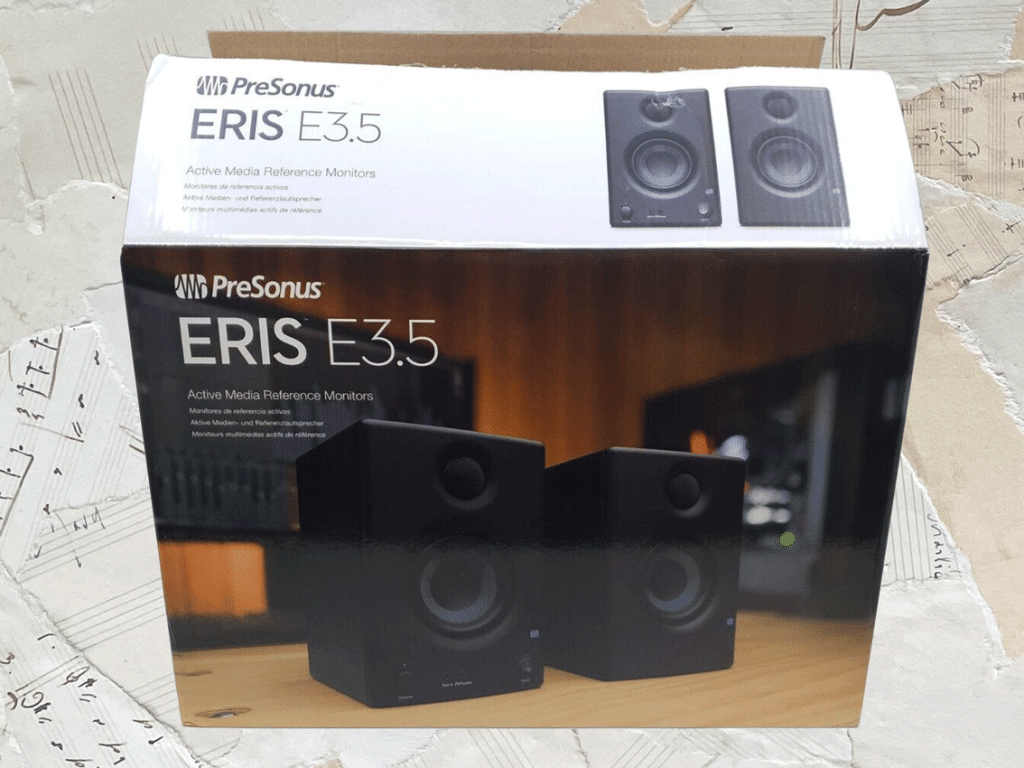
In the box
The PreSonus Eris 3.5 monitors arrived well packed in polystyrene foam, inside a compact cardboard box which also included a:
- lightweight speaker cable (78”)
- 1.5m (59″) 1/8” stereo mini jack cable (TRS to TRS)
- 1.5m (59″) adapter cable (stereo mini jack TRS to 2 x mono RCA)
- 8 foam sticker pads to stop vibration
- 1.8m power cable (71″)
- Quick set up guide
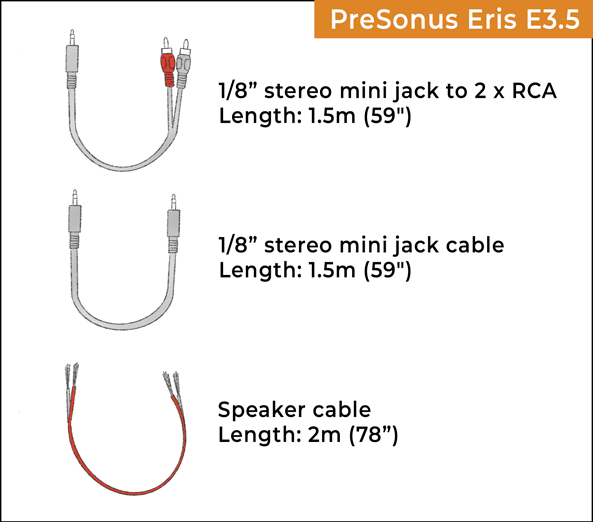
A multitude of controls
The first thing I noticed was that the left monitor was heavier than the right. That’s because there’s only one amp, which is housed in the left unit. This is where you’ll find all the controls too.
And there’s a lot of them for such a small monitor.
On the front is a:
- Volume control
- On off switch
And on the back :
- Treble control
- Bass control
Having a volume control is a feature you’ll often see on computer speakers, but not so often on studio monitors. It’s a welcome addition on these monitors, especially if your audio interface doesn’t have one, or if it’s tucked away in a hard to reach place.
Most studio monitors have on/off switches on the back, where it can be hard to reach. With the Eris E3.5 monitors, PreSonus have followed the lead of computer speakers, by having the switch easily accessible at the front.
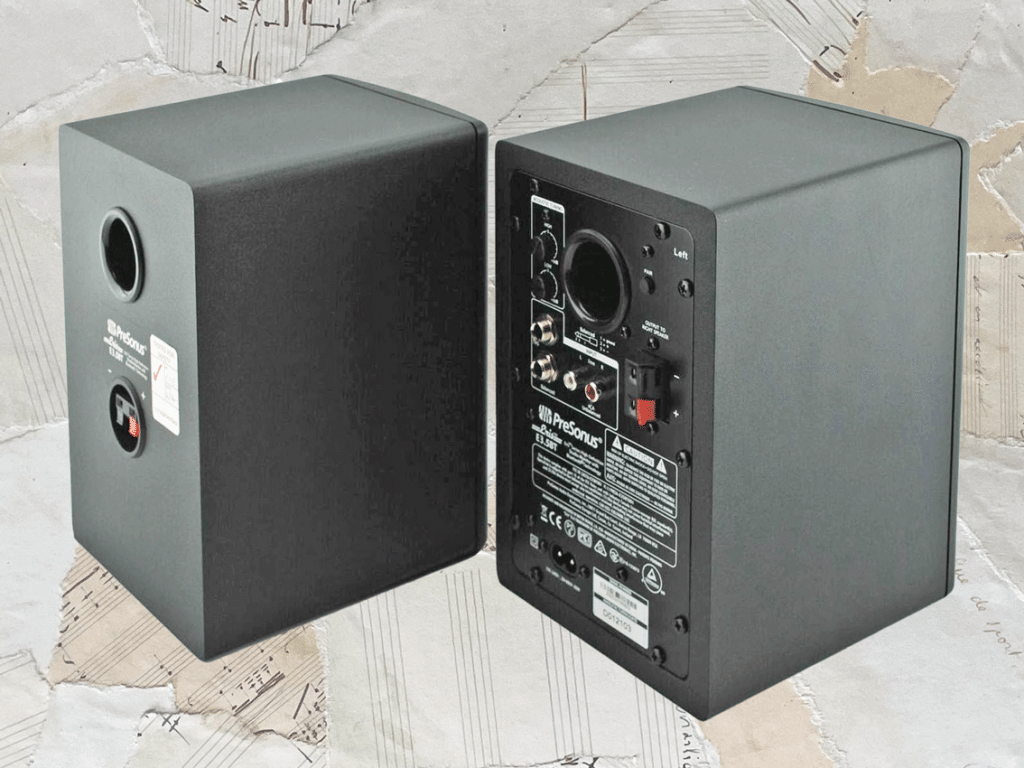
Equalisation options
A major plus of the PreSonus Eris E3.5 monitors, especially at this price point, is the treble and bass controls. You can adjust both treble and bass by plus or minus 6db to compensate for room acoustics.
In practice this flexibility makes quite a difference. While placed on my desktop, I didn’t have to make any adjustments. But if they were up against a wall, it would be good to have the option of lowering the bass if needed.
Don’t be tempted to crank up the bass control to add more bass. It will only muddy the bass that’s already there, rather than extending it. Only make small adjustments if really needed.
Eris E3.5 Connectivity
As well as all the controls, the Presonus Eris E3.5 monitors offer a great deal of options when it comes to connectivity.
On the front there’s a:
- 1/8″ (3.5mm) socket for a phone or similar
- 1/8″ (3.5mm) socket for headphones
And on the back:
- 2 x RCA input sockets, to connect to the computer
- 2 x TRS 1/4″ sockets, to connect to an audio interface
Connecting to the sound source via the TRS sockets into an audio interface will give you a noticeably better sound than using the RCA sockets.
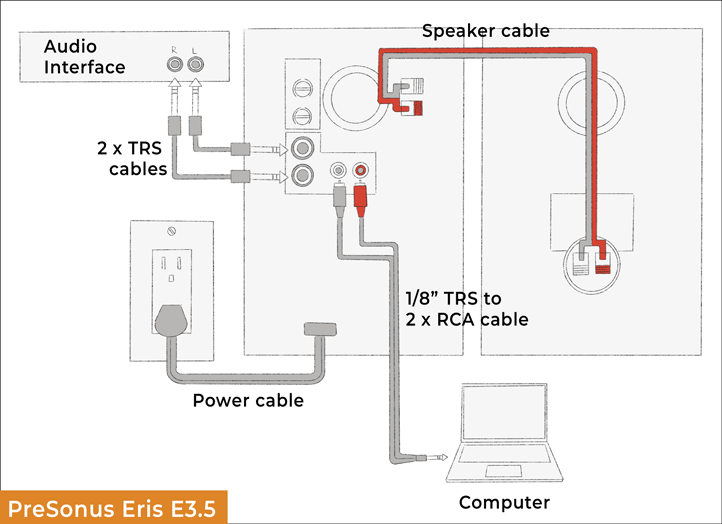
Connecting the Eris 3.5 to an audio interface
If you’re using the PreSonus Eris E3.5 monitors for music production, you’ll need two TRS 1/4″ cables. These are different from the very similar looking TS 1/4″ cables, though both will actually work.
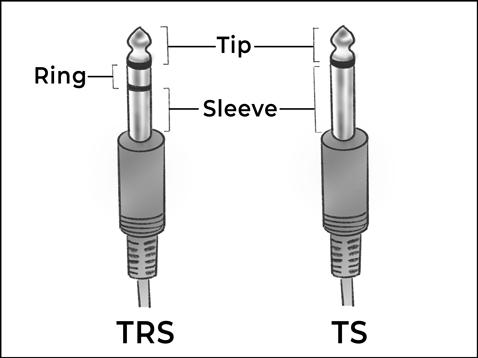
The way to tell them apart is by looking at the connectors. TRS connectors have 2 black lines, but TS connectors have just one.
The advantages of using the proper TRS cables is that the signal will be shielded, and less likely to pick up noisy interference. The signal will also be considerably louder in volume.
How do I choose the best cables?
Connecting to a computer
If you don’t have an audio interface, you can connect the PreSonus Eris E3.5 monitors to your computer using the supplied adapter cable.
The 2 RCA connectors at one end of the cable connect to the RCA sockets on the back of the monitor. And the other end of the cable connects to the mini jack (1/8″) aux out, or headphone socket on the computer.
Construction and materials
The PreSonus Eris E3.5 studio monitors have a lightweight construction, with a plastic front panel, and vinyl laminated MDF case. While they’re not the most luxurious feeling, they have a functional build quality, and serve their purpose well.
There’s a port at the back leading to the area behind the woofer. This helps to disperse some of that low end sound energy into the room.
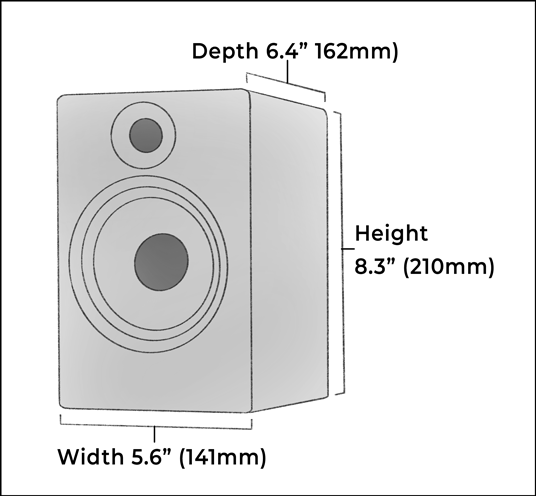
The PreSonus Eris E3.5 monitors stand at a height of 8.3″ (210mm), with a width of 5.6″ (141mm), and a depth of 6.4″ (162mm). Both speakers weigh in at just under 6.4 lb (2.9 kg).
Woofers and tweeters
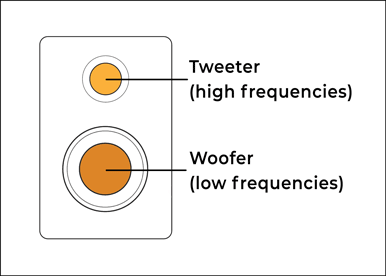
At 3.5 inches, the woofers in the PreSonus Eris E3.5 monitors are tiny compared to most studio monitors. This means there’s a compromise in reproducing some of the lower bass frequencies.
But less bass isn’t always bad for music production.
The PreSonus Eris E3.5 monitors are designed for small spaces, where too much bass would be detrimental to the sound. There’s no point in having the lowest sub-bass if you’re in a small room. The lower frequency sounds would become cluttered and messy. You’d have no way of hearing an accurate representation of your music.
The woofers in the Eris E3.5 monitors share some similarities with the other pro studio monitors in the PreSonus Eris range. They’re made of Kevlar, a fibre also used for bullet proof vests and other things in the aerospace industry.
Kevlar is lightweight, but extremely stiff under tension. The lack of flexibility makes it incredibly efficient at pushing air and shaping it into soundwaves. It’s no wonder that these small monitors seem to pack a punch more inline with bigger speakers.
The silk dome tweeter is 1 inch, which is on the larger side for a computer style monitor. It’s also the same one used in some of the larger PreSonus models.
Frequency response
The PreSonus Eris E3.5 monitors have a frequency response of 80 Hz to 20 Khz. This is an impressive bass extension for such compact monitors, and at this low price point.
Bear in mind that compared to more expensive monitors, with bigger woofers, there’ll be less bass extension. This might be a bit limiting if you need to work on music with subsonic frequencies.
Despite the limited frequency response of the lower bass range, it does have a pleasing balanced sound. And while it may not be an entirely accurate sound for critical mixing, it’s certainly workable for most audio tasks.
The middle and high frequencies are clear and detailed, and would suit anyone working on non-critical music editing, or home video production.
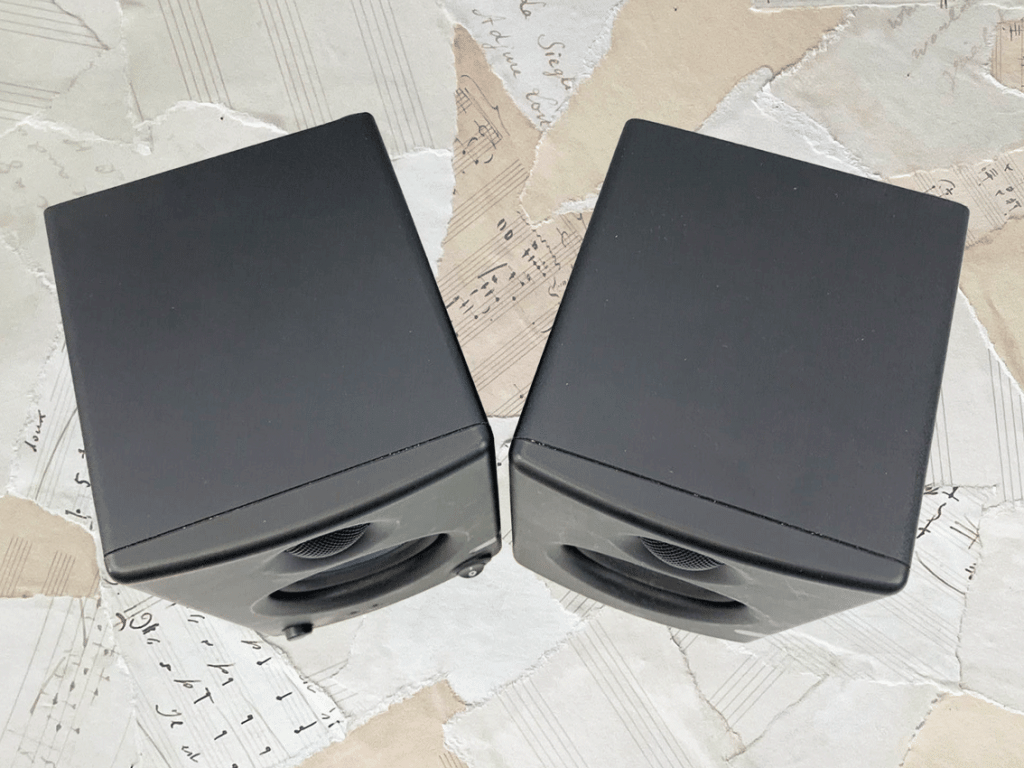
A quick lesson in acoustics
The lowest frequency of the PreSonus Eris E3.5 is 80 Hz.
And an 80 Hz sound wave is actually just over 14 foot long.
This means that the Eris E3.5 is ideally suited to a room of at least 10 x 10 foot, as the diagonal between corners is also just over 14 foot long.
There’s room for a 14 foot soundwave!
We’re talking ideals here, for optimal listening. Don’t worry if your room is smaller than this.
Inside the monitors
The 50 watt class AB amplifier is housed in the left speaker, which is powered by the mains. A speaker cable transmits the signal to the right speaker.
On some of the more high end studio monitors, such as the larger Eris E5, there’s a separate amplifier for both speakers. This provides a step up in sound quality. But PreSonous are working to a budget with the Eris E3.5 monitors, and a separate amplifier in each speaker would probably double the cost.
The class AB amplifier is efficient at minimising crossover distortion. It has a “soft start”, with no loud pop when powering up.
The 50 watts is split into 25 watts per speaker, which is more than enough for monitoring needs. They’re actually surprisingly loud for such small monitors.
There’s also an integrated headphones amplifier to power the headphones output socket on the front panel.
A small blue LED indicates the monitors are switched on.
Design and Styling
The PreSonus Eris E3.5 monitors have an understated minimal design. It has an elegant matt black finish with a blue logo and matching blue power LED.
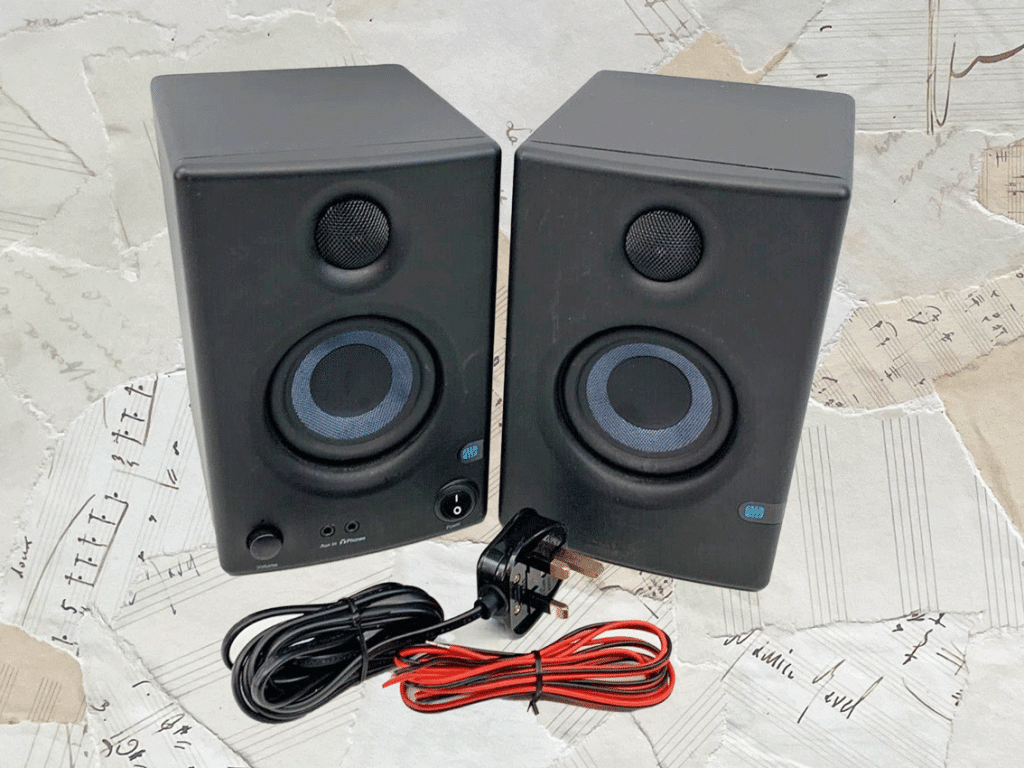
Where to place your Eris 3.5 monitors
The PreSonus Eris E3.5 monitors are designed to be placed on the desk, either side of your computer screen or laptop. Turn each one slightly inwards so they’re both pointing towards your ears.
As near-fields, they’re designed to sound optimal for close up listening. They should form an equilateral triangle, with each speaker and your head in one of the corners. This is called the sweet spot, where the sound will be most accurate.
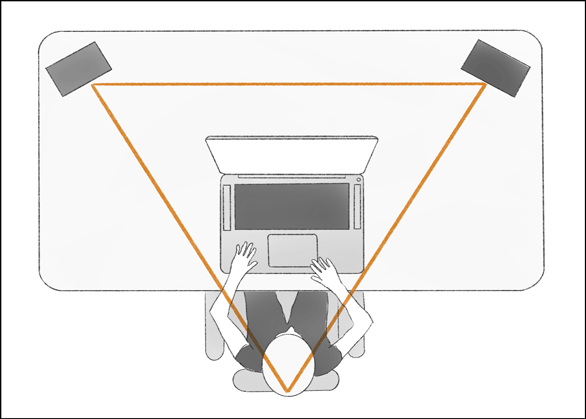
Ideally, the tweeters should be inline with your ears. That’s not always practical for desktop speakers. But you may be able to angle them upwards, so they point to your ears, with ‘angle isolation pads‘.
The PreSonus Eris E3.5 monitors come with 4 thin foam pads which help to stop acoustic energy transferring into the desk. This helps to tighten up the bass, avoiding a muddy and unfocused sound.
For the best acoustic experience, place your desk symmetrically, midway along the wall. This will ensure that both monitors have a similar acoustic environment.
Make sure not to push the monitors up against the wall. They’re rear ported, and will need at least a few inches of breathing space, ideally more.
If you’re stuck for room, and find yourself in a corner, with the monitors up against the wall, here’s a few tips:
- Put something absorbent between the monitor and wall
- Adjust the bass control downwards by a few db
All models in the PreSonus Eris range
| Model | Power (pair) | Frequency response |
| Eris E3.5/E3.5 BT | 50W | 80 Hz to 20 Khz |
| Eris E4.5/E4.5 BT | 50W | 70 Hz – 20 kHz |
| Eris E5 BT | 100W | 53 Hz – 22 kHz |
| Eris E5 | 160W | 53 Hz – 22 kHz |
| Eris E5 XT | 160W | 48 Hz – 20 kHz |
| Eris E7 XT | 280W | 42 Hz – 20 kHz |
| Eris E8 XT | 280W | 35 Hz – 20 kHz |
| Eris E44 (MTM) | 170W | 55 Hz – 22 kHz |
| Eris E66 (MTM) | 290W | 45 Hz – 22 kHz |

Performance
I tested the PreSonus Eris E3.5 monitors with a Metric Halo audio interface (through the balanced TRS outputs).
I was surprised by how loud and punchy they sound. There’s also a lot of clarity in the highs and mids. And the stereo imaging was much more accurate than I expected for the price.
These are studio monitors with small woofers, so I wasn’t surprised to hear a bass roll off from around 80 Hz. This frequency is an octave above the lowest note of a bass guitar, or E2 on a piano. Anything below that isn’t there.
Although I wouldn’t class these as reference monitors with a flat response, there was enough low end energy to get a good idea of what was going on.
They have a clear, integrated sound which was comfortable to listen to for long periods. Maybe very slightly harsh in the upper mids. I found that by checking periodically with some good studio headphones, I could comfortably mix music.
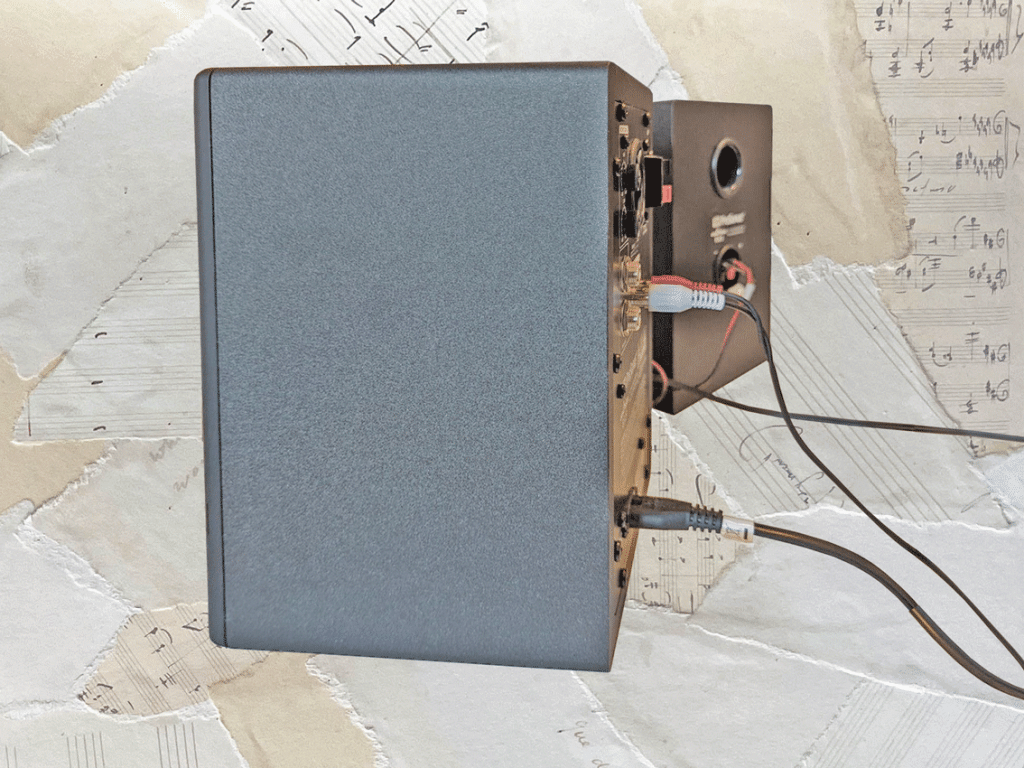
Some simple upgrades
If you’re using these as desktop computer speakers, you should be fine. But if you intend to have them as your main studio monitors, I suggest two upgrades:
- Heavy duty speaker cable
The speaker cable included in the box is very lightweight. Try changing it for heavy duty speaker cable (look for 16 gauge or similar)
- Thick isolation pads
The monitors come with 4 isolation pads, but you could make a big improvement by using something more substantial.
Some isolation pads, like this, allow you to angle the monitors towards your ears, which will give you a far superior listening experience.
Extra: the Studio Magic Bundle
If you register with PreSonus, you’ll gain access to a generous music software bundle which includes:
- Tutorials from Melodics
- Sound libraries from Ghost Hack
- 7 virtual instruments
- 9 effects plug-ins in VST, AU, and AAX formats
- Studio One Prime DAW
There’s some great stuff here, especially if you’re just starting out. The Studio One DAW software comes in its basic form, which has unlimited midi and audio tracks, along with some basic effects.
If you like it, you can upgrade to the Artist version for $99
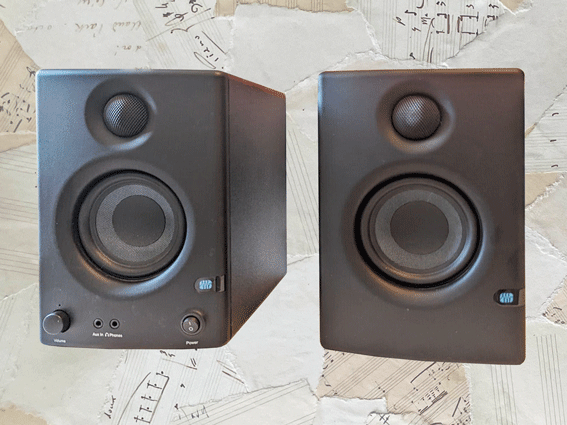
Verdict: The Best Small Studio Monitors?
It’s easy to forget when reviewing these small monitors, that they’re priced at under $100/£100. It’s incredible to think they can be picked up for the price of budget desktop speakers.
As desktop computer speakers, they’re fantastic. You’ll be able to listen to music in detail, at a good volume. You’ll find them a considerable upgrade from other desktop speakers in a similar price bracket.
They’re also a good choice if you need high quality, easily portable speakers for location recording. Or if you’re composing music, programming midi parts or undertaking other pre-production work.
The PreSonus Eris E3.5 monitors are also viable for a home recording studio if you’re buying your first pair, and on a budget. There’s a good clarity on the mids and highs, pretty good stereo imaging, and enough bass energy to get a feel for what’s going on in the mix.
Add to that the ability to cut and boost treble and bass to suit the acoustics of room you’re working in. This is rare for a studio monitor of this price.
For mixing music, I recommend combining them with a pair of good quality studio headphones. You’ll be able to check that bass, as well as the overall balance and soundstage positioning.
For tracking, they’d do a great job. They’ll also double as high quality desktop speakers for gaming, or casual music listening.
I think the PreSonus Eris E3.5 monitors would also suit podcasters, YouTubers, and anyone doing video editing. The recorded voice comes through with great detail.
Need more bass?
If you think you’ll benefit from an extra 10 Hz of bass (adding a few notes down to C#2 on a piano), take a look at the PreSonus Eris E4.5 monitors (Thomann). These are identical to the Eris E3.5 monitors but with slightly larger woofers, extending the bass down to 70 Hz.
Both models are also available with bluetooth connectivity.
There’s also a matching subwoofer by PreSonus, the Eris Sub8, which would bring that bass down to 30 Hz. This could be an option for the future, when budget allows, or for when you move into a bigger room.
PreSonus Eris 3.5 vs Mackie CR3
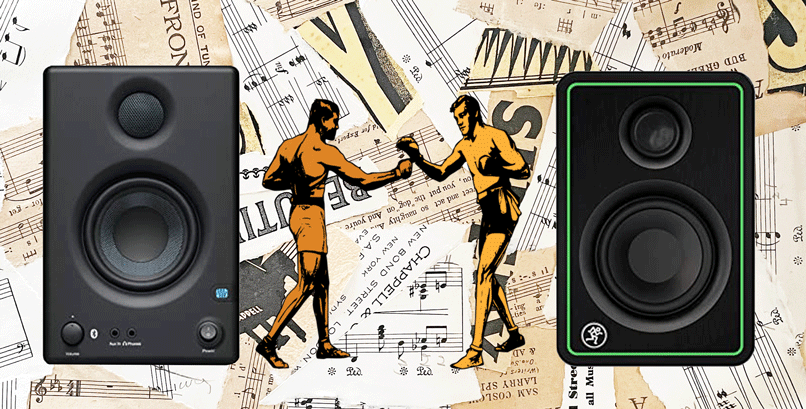
You might have come across the Mackie CR3-X while researching the studio monitor market. They’re also have excellent sound quality and a similar range of features, including the volume knob and headphone output.
The Mackie CR3-X has a slightly smaller 3 inch woofer as apposed to the 3.5 inch on the Eris. This translates into slightly less bass extension. The tweeter is also smaller at 3/4 inch.
There’s no Eq tuning on the Mackie monitors, but they do have the same range of connection ports, as well as a headphone socket.
They’re similarly specified monitors, with nearly the same frequency range, sound quality and sound output. Much of it comes down to personal taste – do you like the understated Eris design, or would you prefer the flashier Mackie?
I’d recommend going for the Presonus Eris E3.5 monitors, as they have slightly larger woofers, and therefore a little more bass extension. There’s also the ability to tune the low and high frequencies with the bass and treble controls.
Summary
I hope this PreSonus Eris E3.5 review has been useful!
In summary, these are budget studio monitors with surprisingly good sound quality. The frequency response is excellent for speakers with such a small footprint.
I do recommend the PreSonus Eris E3.5 monitors if you’re looking for good studio monitors on a budget. I don’t believe you’ll find anything else that comes close for the price.
Common FAQs
Are PreSonus E3.5 monitors good for mixing?
The PreSonus Eris E3.5 monitors are great for mixing if you’re working in a small room or on a budget. Pair them with some decent studio headphones for a complete mixing and mastering set up.
How do I connect the E3.5 monitors to my computer?
You have a great range of options for connecting the E3.5 monitors to your computer. There’s an 1/8″ (3.5mm) socket on the front, and 2 x RCA sockets on the back. If you’re using a soundcard, you can use the TRS ¼” sockets on the back.
Are the Presonus Eris E3.5s active?
The Eris 3.5s are active studio monitors. Active monitors have a dedicated amplifier built into at least one of the speakers, negating the need for a separate amplifier
